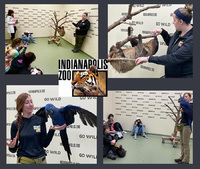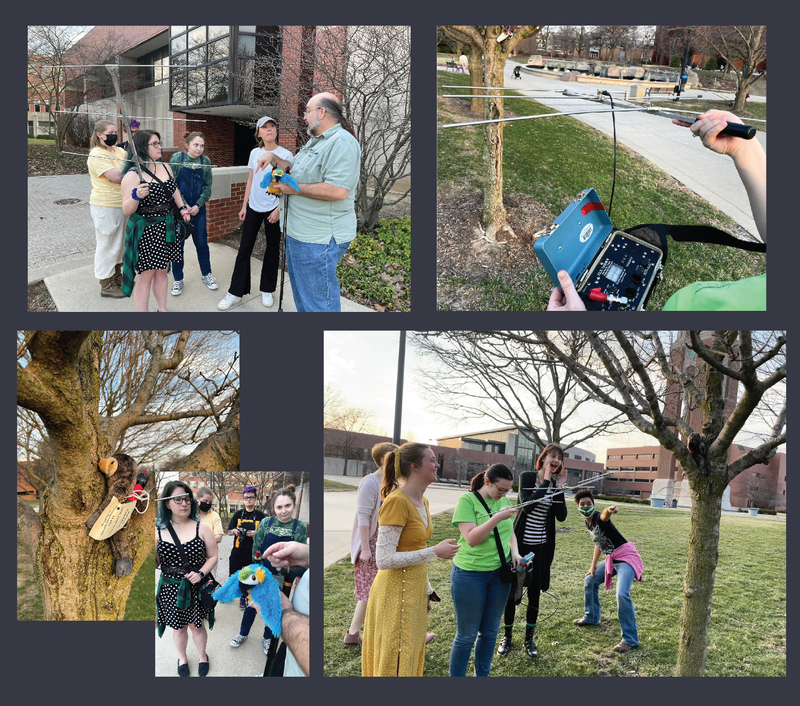Process
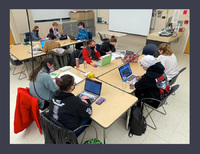
CT Team developing materials for books

Diagram of development process.
(McConnell & Giorgio-Booher, 2020)
Process
The Conservation Tales project has developed a process for a team of students to develop books in a single semester. This page shows key elements in the process.
Click the images to see a larger version.
Each book is created by a team of students including illustrators, science writers, photographers and graphic designers. The process and team structure was developed as the project grew from a single illustrator to the plan you will see in this exhibit.
As the project grew, innovative ideas were suggested by students, and project finally reached its current structure in 2019.
Students in the 2022 cohort describe the key steps process as Observe, Experience, Plan, and Create.
As part of the dissemination of the project, the faculty advisors published an article that includes the figure shown here that explains the process used to develop the books. (McConnell, T. J. & Giorgio-Booher, B. (2020). Collaborative Teams for Self-Publishing: A model for creating locally-relevant educational books. Global Journal of Transformative Education, 2, 33-45.)
The Original Plan
For the last year, our team planned a trip to visit our Content Consultants in Costa Rica. The Sloth Institute and the Macaw Recovery Network had both arrange for us to visit their sites and learn from their teams about sloth and macaw biology, threats to these species, and the conservation and research work being done at their facilities.
However, the trip was canceled due to rising COVID rates in Costa Rica. Our team learned that our plan had to change in the second week of the semester.
Even though we were unable to visit their sites, both of our consulting partners continued to support our project. They communicated with us electronically, and shared images to use in the books. They are also reviewing drafts of the book to help ensure the best quality information in our finished products.
Observe
To replace the lost opportunity to observe scientists, animals and habitats in Costa Rica, our team spent time at three major zoos. The observation process allowed the teams to sketch animals and their keepers, learn about sloths and macaws, and talk about conservation actions that can help protect them.
The Cincinnati Zoo supports the work of The Sloth Institute, so they were an excellent choice as a "content consultant." They are home to a pair of sloths, as well as some macaws. Their team of trainers and encounters facilitators were very helpful.
Zoo Knoxville has close connections with the Macaw Recovery Network, so we also partnered with them. They gave us a behind the scenes look at the macaws they keep as animal ambassadors, and shared how their programs support conservation, including funding the Macaw Recovery Network. They also provided an encounter with Joe, their two-fingered sloth.
Our project has had a long relationship with the Indianapolis Zoo, and we arrange an animal encounter with their education department. Again, we met both sloths and macaws.
All of these partners are also reviewing drafts of the text to ensure accurate and authentic stories.
Experience
To help team members experience the type of scientific processes used by the scientists in Costa Rica, our team took part in a simulated radio telemetry activity.
Radio telemetry is a method used to track animal movements in the wild. The Macaw Recovery Center and The Sloth Institute both use this strategy. And so do some of the wildlife biology projects here at Ball State!
So Dr. McConnell led our simulation using the same equipment as our scientific partners. The teams used receivers and antenna to find the transmitters placed on a sloth and a macaw (plush versions) that were "released" along McKinley avenue.
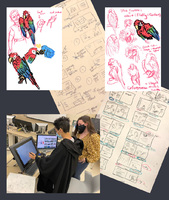
Samples from the storyboards for 2022 books.
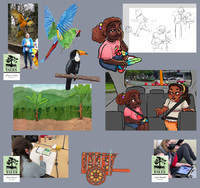
Illustrators for the Macaws book
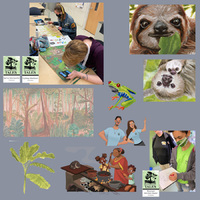
Illustrators for the Sloths book
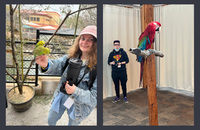
CT photographers Abbey Jessup and Brooke Ackerman

Authors Ashley Owens and Zoe Sherer

Karina Kasmauskis is the team's translator
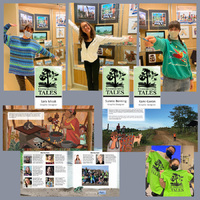
Graphic Designers for the CT team
Planning
The information the team learned through their research, observations and experiences helped them develop the two main elements of the books - the text of the story, and the images used in the book.
Early in the semester, the teams begin creating an outline of the story, identify characters and develop a storyboard for each book. The entire team contributes to this planning.
The science writers then write the drafts of the story while character illustrators design the characters for the book. Other illustrators work on backgrounds, animals and "accents" to be used in the books. The team's photographers help identify and edit photos from the team's observations and from third-party sources.
As the stories developed, Karina Kasmauskis worked to translate the stories to Spanish. The Spanish-language versions will be used by our partners in Costa Rica for their education programs and will be available for other readers.
Throughout the semester, the teams critique their work, revise the story and the images. The graphic designers place the elements of the book in the publishing software used to create the book, and work with the artists and writers to make sure the elements fit together in the available space.
The process is a fluid one, with plenty opportunities for revision and replanning along the way.
Past cohorts have found that the process we use is an excellent match for the process of professionals in the print and digital communcation industries connected to science and education. The tools we use are the industry standard, and so is the structure of the teams. The books we produce will be an excellent addition to our resumés as we near graduation!




